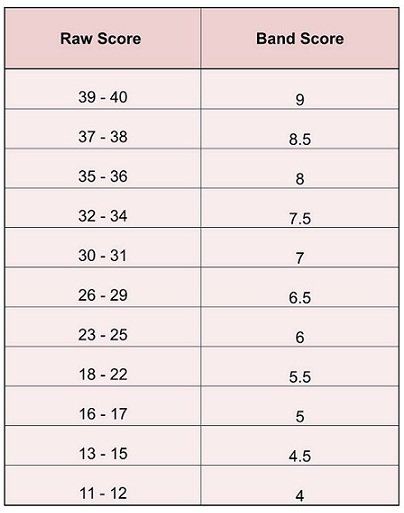The IELTS Listening Test
Find all the key
information you need to know about the IELTS listening test.
On this page you’ll discover:
- The format of the test
- Question types
- Skills assessed
- Marking tips
IELTS Listening Test Format
The Listening test is the same for both the Academic and General exams.
Timing – 30 minutes (plus 10 minutes to transfer the answers to your answer sheet)
Number of questions – 40
Each correct answer is awarded 1 mark. Your score out of 40 (raw score) is converted to the corresponding IELTS band scale level using this conversion table:
IELTS Listening Test Conversion Table

The Listening test is made up of four sections. In each section, you will listen to a recorded text and then answer a series of question on it.
The text will be played only once.
Over the course of the test, you will hear a variety of voices and native-speaker accents such as British English, Australian, American and Canadian. You may also hear a range of different regional British accents.
The Four Sections
These are the 4 parts or sections of the IELTS Listening test.
Section 1 – A conversation between two people set in an everyday social context (e.g. booking tickets to the theatre).
Section 2 – A monologue set in an everyday social context (e.g. a welcome talk for new college students).
Section 3 – A conversation between up to four people set in an educational or training context (e.g. a group of students discussing a university assignment).
Section 4 – A monologue on an academic subject (e.g. a lecture on wildlife).
A monologue is where just one person is speaking.
As you can see, the first two sections of the test relate to social situations, while sections three and four relate to educational and training situations.
Although parts three and four have an academic context, you are not expected to have a detailed knowledge of the topics. It is your listening skills that are being assessed, not your understanding or knowledge of the subject.
2 points to note:
- There will be 10 questions in each section.
- The questions get harder as you progress through the test.
Question Types
You will be asked a variety of different types of questions
selected from this list:
Click the links to see lessons on each type of question.
Skills Assessed
The Listening test is designed to assess your ability to:
|
Marking Tips
It
is important to note that your answers will be marked wrong if:
|
Read the questions very carefully as many will state the number of words you must write or give you a maximum number of words permitted. For example,
|
Write
ONE WORD AND/OR A NUMBER Write ONE WORD ONLY Write NO MORE THAN TWO WORDS |
If you write more words than instructed, your answer will be marked wrong even if you give the correct information.
Don’t throw away marks by making silly mistakes like this.
Now that you understand the format of the IELTS Listening test, it’s time to learn the skills needed to get a high score. Study the lessons below and those on the 10 question types listed above.
Want to watch & listen to this lesson?
Click on this video.
Like this page?
IELTS Listening – All Lessons
IELTS Listening Test – Understand the format & question types. Know what skills are assessed. Also, discover 3 important marking tips.
Listening Strategies – Learn 3 essential listening strategies – question analysis, answer prediction & how to use keyword clues.
Listening Skills – Learn the 4 key listening skills needed for a high score highly. Examples from real questions.
Listening Exercises – 8 listening exercises to help you recognise & learn vocabulary for 6 common topics – time, numbers, prices, dates, letter names & addresses.
The 10 Question Types – Examples of all 10 types of Listening questions. Learn how to recognise & understand them. Links to 10 step-by-step lessons.
Listening Tips – Top 10 tips to bring you success in your Listening test. Essential information you need to know to achieve a high score.
How to Improve Your Listening Skills – 6 simple strategies essential for achieving a high score in the test.
Listening Practice – 4 practice techniques to develop your listening skills
Map & Plan Vocabulary – Learn the vocabulary you need for your test. 5 maps & plans with sample sentences containing common vocabulary of location & direction.
Listening Practice Samples – Short activities to improve your listening skills & help you learn topic vocabulary.
Genuine Full Practice Tests:









